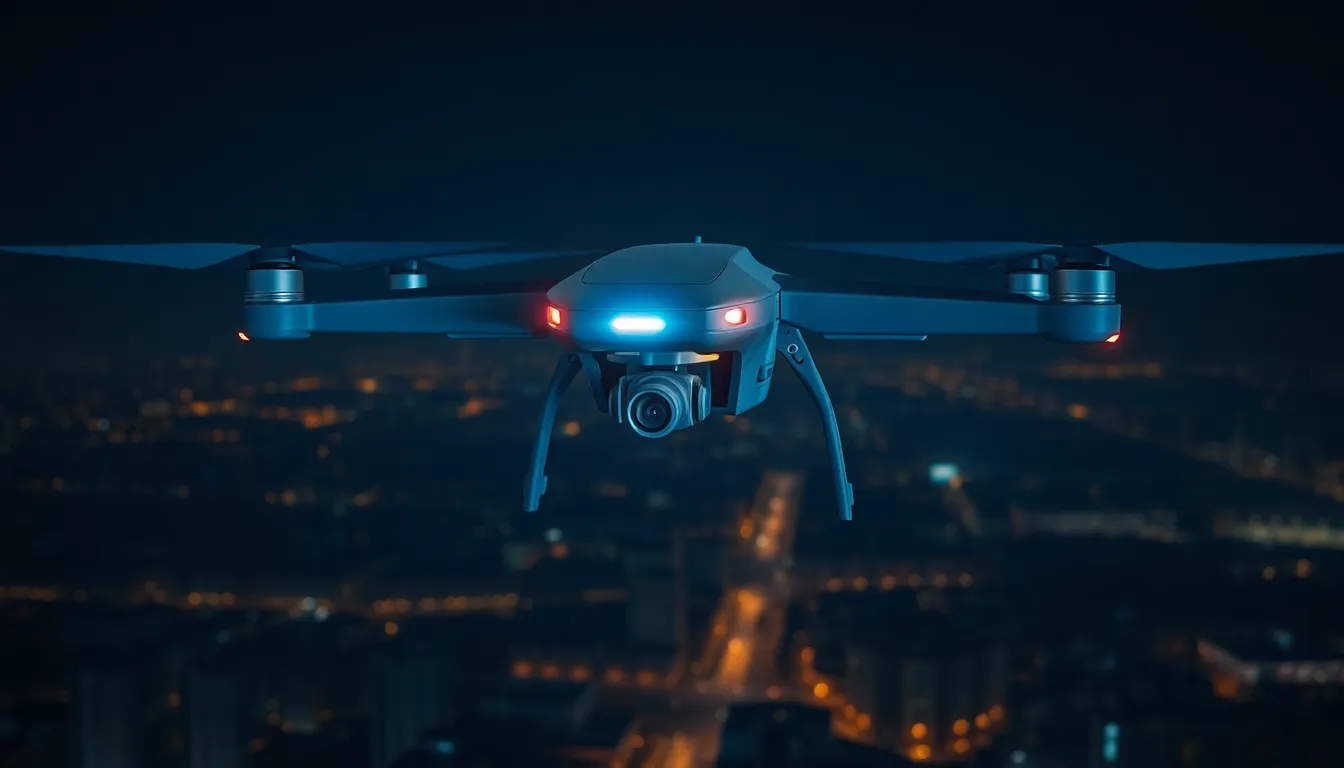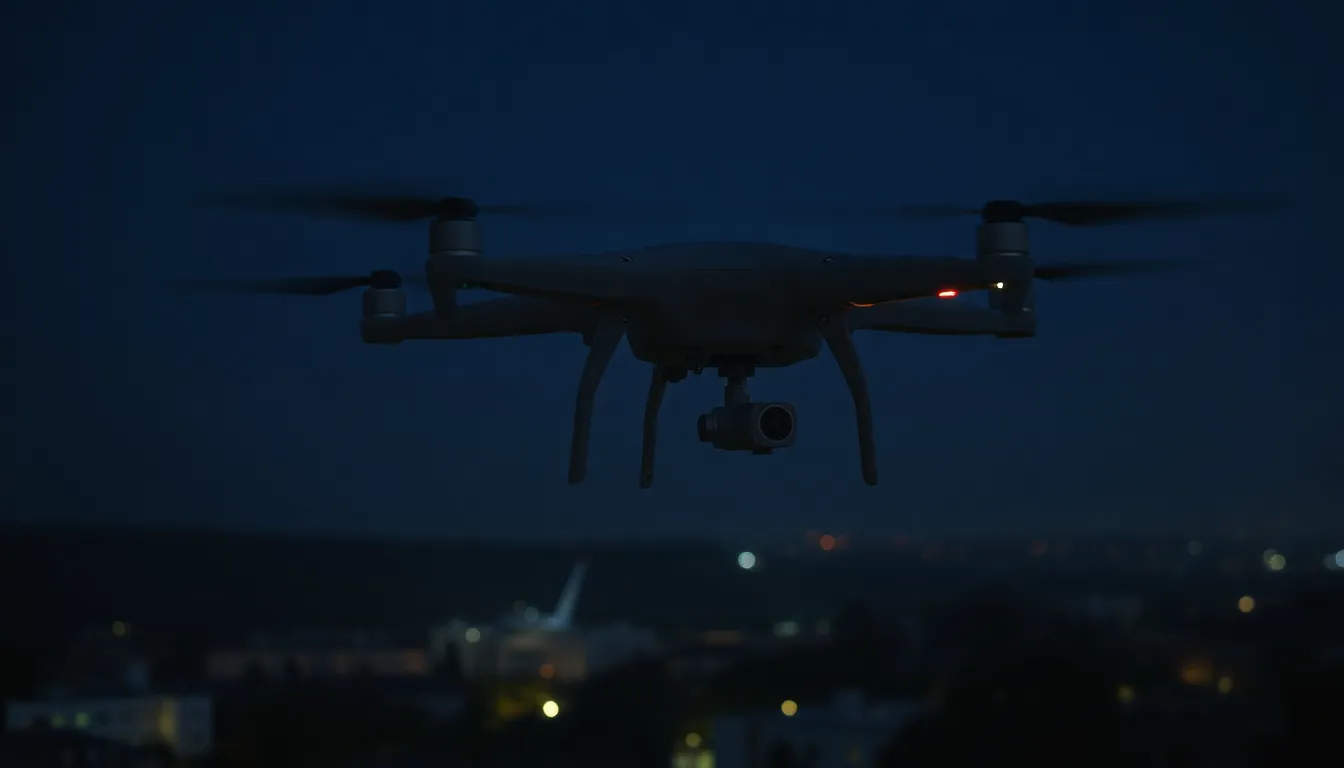As the sun sets and the stars twinkle above, a new kind of surveillance takes to the skies. Government drones, those high-tech marvels of modern engineering, are now soaring through the night. Forget the days of clunky helicopters and overzealous security guards; these sleek gadgets are here to keep an eye on things while you cozy up with your popcorn.
But what’s really going on up there? Are they capturing breathtaking views of the moonlit landscape or simply ensuring that no one’s sneaking a midnight snack from the neighbor’s garden? With their advanced technology and stealthy capabilities, these nocturnal flyers are changing the way governments monitor activities after dark. Join the conversation as we explore the fascinating world of government drones flying at night, and maybe even discover why you should keep your pajamas on when stepping outside.
Table of Contents
ToggleOverview of Government Drones Flying at Night
Government drones operate at night using advanced technologies that enhance their surveillance capabilities. These unmanned aerial vehicles utilize infrared cameras and thermal imaging to detect activities in darkness. Employing cutting-edge sensors, they provide clear visuals regardless of visibility conditions. Nighttime operations allow for 24/7 monitoring, a significant improvement over traditional methods like helicopters and security personnel.
Stealth technology defines modern drones, minimizing noise and making them less detectable to the public. This quiet operation ensures continuous observation without significant disturbance to surrounding areas. With the ability to travel long distances, these drones can cover vast regions effectively. Data collection occurs in real-time, providing instant information to law enforcement and emergency services.
Various agencies deploy these drones for diverse purposes, including crime prevention, search and rescue missions, and wildlife monitoring. Their versatility contributes to increased operational efficiency while enhancing public safety. Flying at night presents unique challenges, yet advances in technology address these issues effectively.
Drones flying after dark raise important privacy concerns among citizens. Understanding the implications of such surveillance remains crucial as technological capabilities expand. Legislators continue to evaluate regulations surrounding nighttime drone operations to balance security measures with personal liberties. Engaging in public discussions about these developments fosters transparency and awareness among communities.
Benefits of Nighttime Operations

Nighttime operations of government drones offer significant advantages. Enhanced surveillance capabilities represent a primary benefit. Drones equipped with thermal imaging and infrared cameras capture details invisible to the naked eye. They provide critical insights during low-light situations, ensuring effective monitoring during nighttime hours. Agencies utilize this technology for missions involving crime detection and rescue efforts, showcasing improved response times and situational awareness.
Reduced detection risks highlight another key benefit of nighttime drone operations. Operating quietly in the dark minimizes the likelihood of detection by potential suspects or threats. Stealthy drones can monitor sensitive areas without alerting individuals, making them ideal for covert surveillance. Authorities gain the ability to track suspicious activities discreetly. Enhanced privacy for citizens arises from these operations, balancing security needs with public peace.
Challenges and Concerns
Government drones operating at night pose significant challenges and concerns. Privacy issues arise as citizens express unease over surveillance without consent. Drones equipped with thermal imaging cameras can infringe on personal space, capturing images and data in areas where individuals expect privacy. This leads to debates about whether such monitoring is necessary for public safety or excessive intrusion.
Safety and regulation represent another critical area of concern. The potential for accidents increases with nighttime operations, especially in urban environments where obstacles exist. Legislators face the challenge of creating applicable regulations that ensure public safety while allowing law enforcement agencies to utilize drones effectively. It’s essential for authorities to establish guidelines that govern flight paths, altitude limitations, and recording practices to reinforce accountability. Balancing law enforcement needs with civilian safety creates a complex regulatory landscape that continues to evolve.
Technology Behind Night Operations
Government drones utilize advanced technology for effective nighttime operations. These unmanned aerial vehicles rely on specialized tools to enhance their functionality in low-light environments.
Infrared and Night Vision Technologies
Infrared cameras and night vision systems serve as essential components of these drones. Infrared technology detects heat signatures, allowing operators to monitor activity even in complete darkness. Night vision capabilities enhance visibility, revealing details undetectable by the naked eye. These systems work together, delivering critical imaging that supports crime prevention and rescue missions. Data collected from these technologies results in improved situational awareness, enabling authorities to act promptly. Surveillance conducted in dark environments proves significantly more efficient than traditional methods. Enhanced imaging not only increases effectiveness but also promotes safety in sensitive operations.
Autonomous Flight Features
Autonomous flight features empower drones to navigate through complex nighttime environments. Advanced navigation systems utilize GPS and sensors to maintain stable flight paths. These features allow drones to fly at required altitudes while avoiding obstacles, contributing to safe operations. Real-time data analysis supports decision-making during missions, ensuring precise and timely responses. Flexibility in flight patterns enhances operational efficiency, catering to various agency needs. Autonomous systems reduce the need for constant human intervention, allowing personnel to focus on strategic objectives. As drone technology evolves, these capabilities continue to enhance nighttime surveillance, underscoring their growing importance in public safety initiatives.
Future of Government Drones Flying at Night
Government agencies increasingly prioritize the use of drones for nighttime operations. Enhanced technology will likely make these unmanned aerial vehicles even more capable. For instance, advancements in artificial intelligence can automate surveillance tasks, improving efficiency and accuracy. Agencies anticipate deploying drones equipped with better imaging systems, which will make low-light monitoring even more effective.
Cities may invest in drone fleets to support various missions. Monitoring traffic patterns during off-peak hours could optimize public safety without disrupting nighttime activities. Niche operations, such as border surveillance and natural disaster assessments, stand to benefit significantly from reliable nighttime capabilities.
Challenges will evolve as technology advances. Ethical concerns about privacy will remain a focal point for public discourse. They will require regulators to formulate policies ensuring accountability while fostering innovation. Proactive discussions among stakeholders—government officials, privacy advocates, and the public—might help create a balanced approach to nighttime surveillance.
Education and training for drone operators will also be crucial. Specialized training programs could equip personnel with the necessary skills to navigate complex environments safely. Formalized certification processes can ensure that operators understand both the technology and ethical implications of deployment.
Data security will play a significant role in future developments. It is essential that agencies safeguard the sensitive information collected by these drones. Ensuring data encryption and creating protocols for data access will enhance public trust. By addressing these factors, agencies can demonstrate their commitment to responsible drone usage.
Expanding the nighttime operational capabilities of drones marks a vital step in modern surveillance strategy. As technological advancements shape government initiatives, the interplay between security needs and citizen privacy will continue to evolve.
The rise of government drones flying at night represents a significant shift in surveillance practices. Their advanced technology enhances public safety while also raising important privacy concerns. As agencies continue to deploy these drones for various missions their impact on communities will be profound.
Balancing security needs with individual rights will be crucial as regulations evolve. Ongoing public discussions about the implications of nighttime surveillance are essential for fostering transparency and trust. The future of drone operations will likely depend on how well society navigates these challenges while embracing the benefits of innovative technology.



